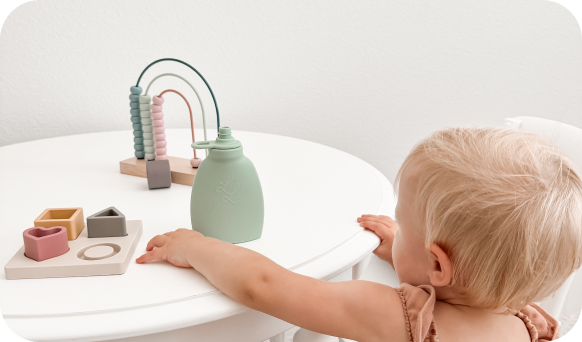Easy & Delicious Baby Puree Recipes Your Little One Will Love

Making your own baby purees might sound like a lot of work, but it’s actually pretty simple. It’s also kind of fun to play around with different flavors and see which ones your baby likes best.
It’s all about giving your Little one the best start possible, and homemade purees let you do just that, one spoonful at a time.
Essential Takeaways:
- Perfect Purees for a Healthy Start: Starting your baby on solids with homemade purees puts you in control, ensuring they enjoy the freshest, most nutritious meals. Free from preservatives and additives, these purees offer your baby the very best right from their first bite.
- Simplify Feeding with Purees: Make the transition to solid foods easier by storing and serving your baby’s healthy, homemade purees in our reusable baby food pouches. Perfect for busy parents on the go, these pouches allow you to provide nutritious meals to your Little one anytime, anywhere.
Let’s dive into how purees can play an important role in your baby’s early eating experiences and why whipping them up at home might just become your new favorite thing.
- Starting Solids: The Role of Purees in Your Baby’s Diet
- Nutritional Considerations for Baby Purees
- Easy & Nutritious Puree Recipes for Your Little One
- Tips for Preparing and Storing Baby Purees
- Expanding Your Baby’s Palate: Introducing Tastes and Textures
- Homemade Purees: Nourishing Your Baby with Love and Nutrition
Starting Solids: The Role of Purees in Your Baby’s Diet
When it comes to introducing your baby to solid foods, purees can be a real game-changer. They’re often the first step away from exclusive breastfeeding or formula, marking a big milestone in your baby’s growth.
Recognizing the Signs That Baby is Ready for Solids
But when do you start solids? Typically, around 6 months old is when most babies show certain signs that they are ready to explore new foods, including:
- They can sit up with minimal support.
- They show curiosity about your food.
- They can make chewing motions.
- They don’t automatically push solids out of their mouth with their tongue.
Starting with purees allows your baby to get used to different tastes and textures at their own pace. Purees are easily digestible, making them a great way to introduce a variety of fruits, vegetables, and eventually proteins into their diet. Remember, the goal here is to complement their milk diet, not replace it. So, keep those breast or bottle feedings going strong.¹
Just starting your baby on solids? Learn how to introduce stage 1 foods with our comprehensive guide.
Nutritional Considerations for Baby Purees
As you whip up those first batches of purees, nutrition is key. Your baby’s little body is growing at an incredible rate, and they need the right nutrients to support that growth. Here’s what to focus on:
- Iron: Iron-rich foods like spinach, lentils, and iron-fortified cereals are great options. These foods are especially crucial for breastfed babies, as their iron stores start to dip around 6 months.
- Zinc: Good sources include meat, beans, and whole grains. This nutrient is important for immune function and cell growth.
- Vitamins A, C, and D: Sweet potatoes and carrots are fantastic sources of Vitamin A, citrus fruits have Vitamin C, and for Vitamin D, get a bit of sunshine and supplements as recommended by your pediatrician.
- Healthy Fats: Avocado and pureed salmon are excellent for brain development, thanks to their Omega-3 fatty acid content.
- Whole Grains: Add whole grains like quinoa, ground oats, or barley into your baby’s purees for a delicious way to introduce texture and nutrition. Quinoa, for instance, is high in protein and easy to digest when cooked and pureed. Ground oats can be cooked until soft and mixed with fruits or vegetables for a smooth, fiber-rich meal.²
Incorporating a variety of these nutrients into your baby’s purees not only supports their physical development but also sets the stage for healthy eating habits as they grow. Mix and match ingredients to create a well-rounded menu, and don’t shy away from adding a tiny pinch of spices to introduce new flavors.
Remember, each baby is different, so what works for one might not work for another. Start slowly, watch for allergies, and enjoy the process of introducing your baby to the wonderful world of food, one puree at a time.
Easy & Nutritious Puree Recipes for Your Little One
Whether you’re looking for vitamin-packed fruits, vegetable blends, or iron-rich proteins, these easy recipes ensure your Little one enjoys a variety of flavors and nutrients.
Iron-Rich Spinach and Apple Puree
Prep Time: 20 minutes
Ingredients:
1 cup of fresh spinach
1 medium apple, peeled and chopped
Water as needed
Instructions:
- Steam the spinach and apple together until tender.
- Blend the steamed spinach and apple, adding water gradually until you reach the desired consistency.
Vitamin-Packed Sweet Potato and Apple Puree
Prep Time: 30 minutes
Ingredients:
1 sweet potato
1 apple, peeled and chopped
Dash of cinnamon (optional)
Instructions:
- Bake the sweet potato until tender, and steam the apple until soft.
- Blend the sweet potato and apple together, adding a pinch of cinnamon, if desired, for a cozy flavor.
Protein-Packed Lentil Puree
Prep Time: 5 minutes – If you need to cook the lentils and carrots, add about 35 minutes.
Ingredients:
½ cup cooked lentils
¼ cup cooked carrots
Water or breastmilk as needed
Instructions:
- Blend the cooked lentils and carrots together, adding a little water or breastmilk gradually until smooth.
Note: Keep in mind that preparation times can vary based on factors like the power of your steamer or blender and the ripeness of your ingredients. It’s always a good idea to set aside some extra prep time, especially when preparing baby food to ensure everything is perfectly smooth and safe for your baby to eat.
Get more delicious homemade puree recipes your baby will love in our free recipe guide: Easy Baby Food Recipes for Busy Moms.
Tips for Preparing and Storing Baby Purees
Making baby food purees at home isn’t just about creating healthy meals. It’s also about ensuring these meals are ready whenever your baby is. Here’s how you can prepare and store your homemade purees with ease:
Preparing in Bulk
- Plan Ahead: Dedicate a couple of hours, perhaps each Sunday, to preparing several puree recipes in bulk. This way, you have a variety of options ready to go.
- Blend to Perfection: Ensure your purees are smooth to avoid any choking hazards. As your baby gets older, you can introduce more texture.
Storing for Freshness
- Freezing: Pour purees into ice cube trays or silicone baby food pouches and freeze. Once solid, transfer cubes to a freezer-safe bag labeling each bag with the recipe name and date.
- Refrigerating: Store fresh purees in the fridge in an airtight container for 48-72 hours.
PRO TIP: Use The Palmetto Pouch to store and feed your purees in one! Our reusable baby food pouches are freezer and dishwasher-safe.
Reheating Tips
- Thaw Safely: Move frozen puree to the fridge the night before use or thaw by placing it in a bowl over a pot of warm water. Or, using a Palmetto Pouch, you may place directly into a pot of warm water.
- Warm Gently: Reheat purees in a microwave-safe dish, stirring thoroughly to prevent hot spots. Always test the temperature thoroughly before feeding.
With these tips, you’re all set to give your baby delicious, nutritious meals that support their development and introduce them to the wonderful world of flavors. Remember, each baby will be ready for textures and types of foods in their own time.
Be sure to proceed at a pace that’s comfortable for both of you, and always consult with your pediatrician regarding your baby’s diet.
Expanding Your Baby’s Palate: Introducing Tastes and Textures
As your baby becomes more comfortable with smooth purees, it’s time to start thinking about how to gradually introduce more complex textures and new taste combinations. This ensures your baby gets the nutrition they need while developing their eating skills and learning to enjoy a wider variety of flavors.
Here are some strategies to make expanding your baby’s palate a fun and enriching experience for both of you:
Start Slowly with Texture: Once your baby is used to smooth purees, introduce slightly thicker textures by mashing foods with a fork instead of blending them into a complete puree. This helps them get used to different mouth feels and prepares them for more solid foods.
Mix and Match Flavors: Begin combining flavors by mixing familiar purees with new ones. For instance, if your baby loves apple puree, mix in a bit of mashed carrot to introduce a new flavor and nutrient profile. This not only broadens their palate but also increases their nutrient intake.
Introduce Tiny Soft Chunks: As your baby gets used to thicker purees, start adding tiny, soft-cooked pieces of vegetables, fruits, or well-cooked grains like quinoa or soft rice into their meals. This change encourages chewing motions, even if they don’t have teeth yet.
Let Them Explore: Encourage your baby to explore food with their hands. Yes, it will get messy, but touching and squishing food helps babies learn about textures and may make them more willing to taste new things.
Use Responsive Feeding Techniques: Pay close attention to your baby’s reactions to new textures and flavors. If they seem hesitant, don’t push. Instead, try again in a week or two. Always follow your baby’s hunger and fullness cues, offering new foods when they’re interested and not forcing them when they’re not.
Keep It Safe: Remember, safety first. Ensure that all foods are cooked to the right texture to avoid choking hazards, and always supervise your baby while they eat.
Patience is Key: Expanding your baby’s palate is a gradual process. Each baby is unique, and their readiness for new textures and tastes will vary. Keep offering new foods without pressure, and over time, they’ll likely become more adventurous eaters.
By introducing a variety of textures and tastes and encouraging your baby to explore food in a supportive and responsive way, you’re laying the groundwork for healthy eating habits that will benefit them for years to come.¹
Homemade Purees: Nourishing Your Baby with Love and Nutrition
Making baby food purees at home is more than just a way to feed your Little one—it’s an act of love that nurtures their growth and development from the very first bite. The journey of introducing your baby to solid foods is filled with joy, a little bit of mess, and a lot of love. By choosing to make your own baby purees, you’re ensuring they receive the freshest, most nutritious meals, tailored to their needs and preferences.
Make Mealtime Mess-Free with The Palmetto Pouch
To make this journey easier and more enjoyable, try The Palmetto Pouch. These reusable baby food pouches offer an easy, mess-free way to store and serve your homemade purees, whether you’re at home or on the go.
The Palmetto Pouch is designed with both parents and babies in mind, making it easier than ever to feed your baby nutritious, homemade meals anytime, anywhere.
Simplify Introducing Solids
Introduce solid foods to your baby the easy way with The Palmetto Pouch. Shop now and join a community of parents who are committed to providing the very best for their Little ones, one puree at a time.
Shop The Palmetto Pouch now, and make every mealtime a breeze.
References:
- Centers for Disease Control and Prevention. (2023). When, What, and How to Introduce Solid Foods. Retrieved from https://www.cdc.gov/nutrition/infantandtoddlernutrition/foods-and-drinks/when-to-introduce-solid-foods.html
- American Academy of Pediatrics. (2021). Infant Food and Feeding. Retrieved from https://www.aap.org/en/patient-care/healthy-active-living-for-families/infant-food-and-feeding/
